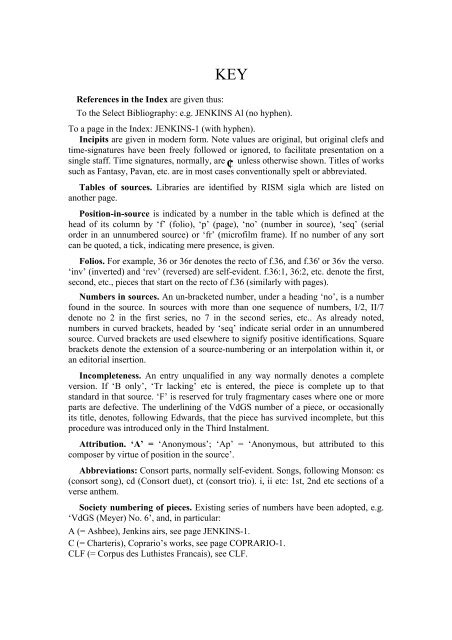THEMATIC INDEX MUSIC FOR VIOLS - Viola da Gamba Society
THEMATIC INDEX MUSIC FOR VIOLS - Viola da Gamba Society
THEMATIC INDEX MUSIC FOR VIOLS - Viola da Gamba Society
You also want an ePaper? Increase the reach of your titles
YUMPU automatically turns print PDFs into web optimized ePapers that Google loves.
KEYReferences in the Index are given thus:To the Select Bibliography: e.g. JENKINS Al (no hyphen).To a page in the Index: JENKINS-1 (with hyphen).Incipits are given in modern form. Note values are original, but original clefs andtime-signatures have been freely followed or ignored, to facilitate presentation on asingle staff. Time signatures, normally, are unless otherwise shown. Titles of workssuch as Fantasy, Pavan, etc. are in most cases conventionally spelt or abbreviated.Tables of sources. Libraries are identified by RISM sigla which are listed onanother page.Position-in-source is indicated by a number in the table which is defined at thehead of its column by ‘f’ (folio), ‘p’ (page), ‘no’ (number in source), ‘seq’ (serialorder in an unnumbered source) or ‘fr’ (microfilm frame). If no number of any sortcan be quoted, a tick, indicating mere presence, is given.Folios. For example, 36 or 36r denotes the recto of f.36, and f.36' or 36v the verso.‘inv’ (inverted) and ‘rev’ (reversed) are self-evident. f.36:1, 36:2, etc. denote the first,second, etc., pieces that start on the recto of f.36 (similarly with pages).Numbers in sources. An un-bracketed number, under a heading ‘no’, is a numberfound in the source. In sources with more than one sequence of numbers, I/2, II/7denote no 2 in the first series, no 7 in the second series, etc.. As already noted,numbers in curved brackets, headed by ‘seq’ indicate serial order in an unnumberedsource. Curved brackets are used elsewhere to signify positive identifications. Squarebrackets denote the extension of a source-numbering or an interpolation within it, oran editorial insertion.Incompleteness. An entry unqualified in any way normally denotes a completeversion. If ‘B only’, ‘Tr lacking’ etc is entered, the piece is complete up to thatstan<strong>da</strong>rd in that source. ‘F’ is reserved for truly fragmentary cases where one or moreparts are defective. The underlining of the VdGS number of a piece, or occasionallyits title, denotes, following Edwards, that the piece has survived incomplete, but thisprocedure was introduced only in the Third Instalment.Attribution. ‘A’ = ‘Anonymous’; ‘Ap’ = ‘Anonymous, but attributed to thiscomposer by virtue of position in the source’.Abbreviations: Consort parts, normally self-evident. Songs, following Monson: cs(consort song), cd (Consort duet), ct (consort trio). i, ii etc: 1st, 2nd etc sections of averse anthem.<strong>Society</strong> numbering of pieces. Existing series of numbers have been adopted, e.g.‘VdGS (Meyer) No. 6’, and, in particular:A (= Ashbee), Jenkins airs, see page JENKINS-1.C (= Charteris), Coprario’s works, see page COPRARIO-1.CLF (= Corpus des Luthistes Francais), see CLF.
















